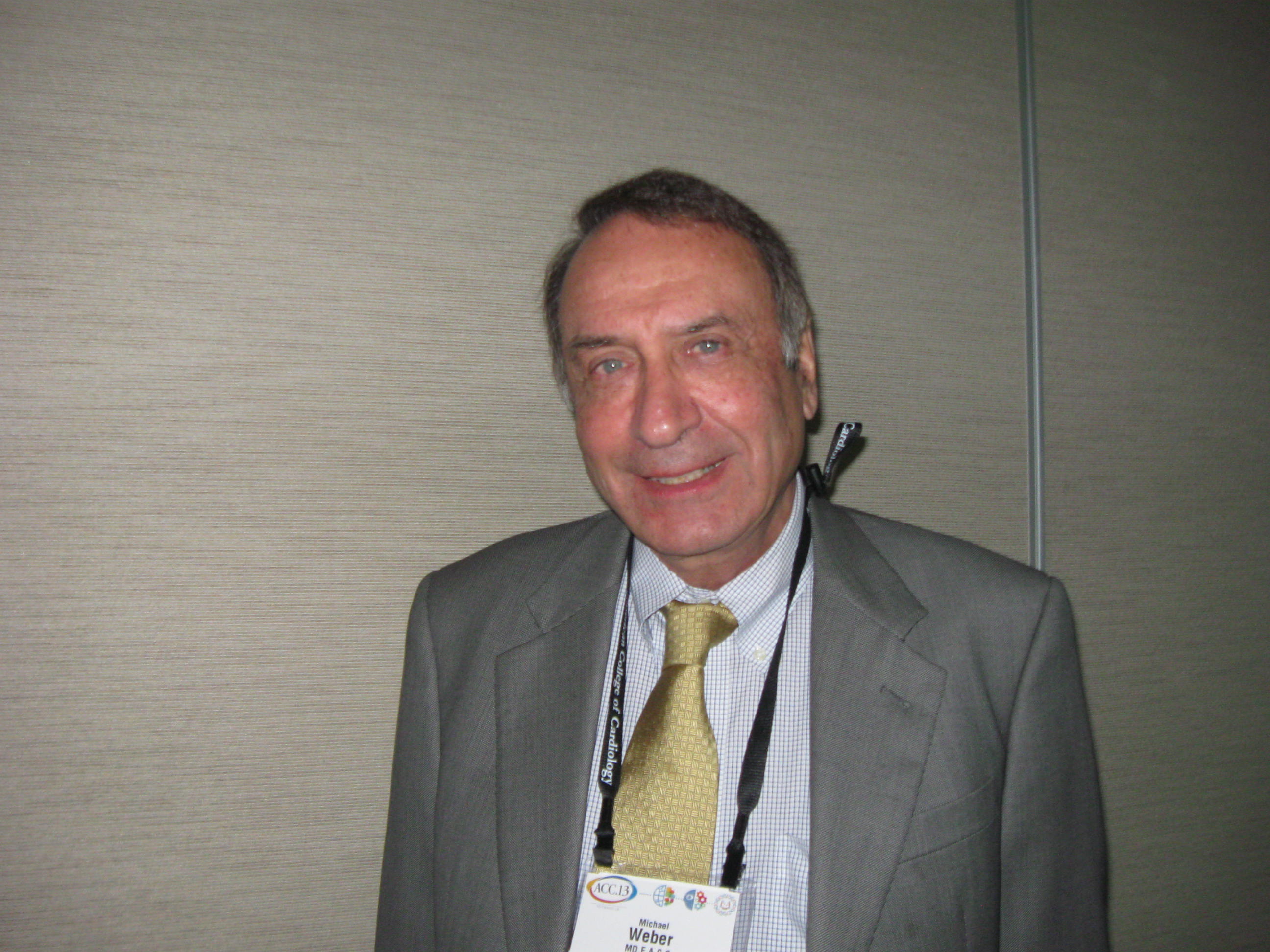User login
SAN FRANCISCO – Treating patients with high-risk hypertension to bring systolic blood pressure below 140 mmHg but no lower than 130 mmHg appeared to be the best therapeutic target in a pre-specified analysis of data on 10,705 patients from the ACCOMPLISH trial.
Every endpoint used to assess outcomes improved significantly if systolic pressure was brought to 130-139 mmHg, compared with higher pressures. Achieving a systolic pressure of 120-129 mmHg was not much more beneficial for patients, however, and more aggressive reductions to 110-119 mmHg were harmful to some patients, Dr. Michael A. Weber and his associates reported at the annual meeting of the American College of Cardiology.
Reaching systolic pressures below 120 mmHg reduced the risk of stroke, but was associated with two coronary events for every stroke prevented, said Dr. Weber, professor of medicine at the State University of New York Downstate College of Medicine, Brooklyn.
The investigators pooled data on patients in the randomized, controlled avoiding cardiovascular events through combination therapy in patients Living with systolic hypertension (ACCOMPLISH) trial, which found that combination therapy using an angiotensin converting enzyme (ACE) inhibitor plus the calcium channel blocker amlodipine was superior to an ACE inhibitor plus the diuretic hydrochlorothiazide (New Engl. J. Med. 2008; 359:2417-28).
For the current analysis, the researchers divided the patients into four groups based on the blood pressure goals they achieved: 110 mmHg to less than 120 mmHg; 120 mmHg to less than 130 mmHg; 130 mmHg to less than 140 mmHg, and 140 mmHg or higher.
Reducing systolic pressure to 130-139 mmHg reduced the relative risk for the trial’s primary endpoint (a composite of cardiovascular death, non-fatal MI, or non-fatal stroke) by 38%. The actual risk reduction was to a rate of 5%, compared with an 8% risk with pressures of 140 mmHg or higher.
All but one of the individual outcomes also improved significantly in the 130-139 mmHg range, as compared with higher pressures. Relative risk of cardiovascular death decreased by 36%; the total MI rate fell by 37%; and the total stroke rate decreased by 47%. Only the risk of coronary revascularization did not improve significantly in patients whose systolic pressure declined to 130-139 mmHg.
Lowering systolic pressure further to 120-129 mmHg produced benefits similar to those seen in the 130-139 mmHg group, with the exception of kidney function, Dr. Weber said. Serum creatinine measurements showed that optimal blood pressures for the kidneys were below 140 mmHg but not less than 130 mmHg.
Compared with a systolic pressure of 130-139 mmHg, reducing pressure to 120-129 mmHg did not significantly reduce risks beyond a reduced likelihood of an increased serum creatinine level.
Except for total stroke risk, the benefits of lowering systolic pressure declined if systolic pressure went below 120 mmHg. The relative risk of the composite endpoint was 37% higher and the relative risk of MI was 48% higher in the under 120 mmHg group, compared with the 120-129 mmHg group, but the risk of stroke was 40% lower.
The stroke risk was a mixed picture, however. There was a blip of increased stroke risk in the 120-129 mmHg group, compared with the 110-119 mmHg and the 130-139 mmHg groups. Dr. Weber speculated that the risks for different kinds of strokes vary, with low blood pressures better for preventing hemorrhagic stroke and higher levels better for preventing ischemic stroke.
Compared with patients with systolic pressures of 120-129 mmHg, those with systolic pressures less than 120 mmHg avoided three strokes per 100 patient-years but had 6 coronary events per 100 patient-years. "So, the cost of preventing one stroke is two coronary events," he said.
Patients in the analysis had a mean age of 68 years; 61% were male, 60% had diabetes, and 46% had a history of coronary disease. After treatment, 22% had systolic pressures of 140 mmHg or higher, 32% had levels of 130-130 mmHg, 34% reached 120-129 mmHg, and 12% reached pressures below 120 mmHg.
In previous randomized trials, significantly fewer cardiovascular events occurred if systolic pressures were below 160 mmHg, as compared with higher pressures. Major guidelines recommend a systolic blood pressure goal of less than 140 mmHg, though prospective trial data to support this target have been lacking, he said.
Novartis funded the ACCOMPLISH trial. Dr. Weber has reported financial associations with Novartis, Boehringer Ingelheim, Bristol-Myers Squibb, Daiichi, Sankyo, Forest Pharmaceuticals, GlaxoSmith-Kline, Sanofi-Aventis, Gilead, and Takeda Pharmaceuticals North America. Some of his associates in the trial reported associations with multiple companies.
Dr. Weber’s findings help refine the "sweet spot" of systolic blood
pressure goals when treating patients with high-risk hypertension. There
is sometimes a tendency to overtreat individuals and aggressively meet
blood pressure targets that are lower than those supported by the
evidence.
This study provides additional information to suggest that just getting
people below 140 mmHg, but not lower than 130 mmHg, is adequate and that
finding is consistent with other data.
Dr. JoAnne M. Foody |
The findings also provide additional support for clinical guidelines
that are moving toward slightly less stringent blood pressure targets
than in the past, appreciating that treating to blood pressures lower
than 120 mmHg may not be as beneficial as previously thought.
The calculation that treating to systolic pressures below 120 mmHg would
cause two coronary events for every stroke prevented caught the ears of
clinicians in the audience. Teasing out that finding was clearly helpful
from a clinical perspective.
Dr. JoAnne M. Foody is an associate professor of medicine and medical
director of the Cardiovascular Wellness Service at Harvard University,
Boston.
Dr. Weber’s findings help refine the "sweet spot" of systolic blood
pressure goals when treating patients with high-risk hypertension. There
is sometimes a tendency to overtreat individuals and aggressively meet
blood pressure targets that are lower than those supported by the
evidence.
This study provides additional information to suggest that just getting
people below 140 mmHg, but not lower than 130 mmHg, is adequate and that
finding is consistent with other data.
Dr. JoAnne M. Foody |
The findings also provide additional support for clinical guidelines
that are moving toward slightly less stringent blood pressure targets
than in the past, appreciating that treating to blood pressures lower
than 120 mmHg may not be as beneficial as previously thought.
The calculation that treating to systolic pressures below 120 mmHg would
cause two coronary events for every stroke prevented caught the ears of
clinicians in the audience. Teasing out that finding was clearly helpful
from a clinical perspective.
Dr. JoAnne M. Foody is an associate professor of medicine and medical
director of the Cardiovascular Wellness Service at Harvard University,
Boston.
Dr. Weber’s findings help refine the "sweet spot" of systolic blood
pressure goals when treating patients with high-risk hypertension. There
is sometimes a tendency to overtreat individuals and aggressively meet
blood pressure targets that are lower than those supported by the
evidence.
This study provides additional information to suggest that just getting
people below 140 mmHg, but not lower than 130 mmHg, is adequate and that
finding is consistent with other data.
Dr. JoAnne M. Foody |
The findings also provide additional support for clinical guidelines
that are moving toward slightly less stringent blood pressure targets
than in the past, appreciating that treating to blood pressures lower
than 120 mmHg may not be as beneficial as previously thought.
The calculation that treating to systolic pressures below 120 mmHg would
cause two coronary events for every stroke prevented caught the ears of
clinicians in the audience. Teasing out that finding was clearly helpful
from a clinical perspective.
Dr. JoAnne M. Foody is an associate professor of medicine and medical
director of the Cardiovascular Wellness Service at Harvard University,
Boston.
SAN FRANCISCO – Treating patients with high-risk hypertension to bring systolic blood pressure below 140 mmHg but no lower than 130 mmHg appeared to be the best therapeutic target in a pre-specified analysis of data on 10,705 patients from the ACCOMPLISH trial.
Every endpoint used to assess outcomes improved significantly if systolic pressure was brought to 130-139 mmHg, compared with higher pressures. Achieving a systolic pressure of 120-129 mmHg was not much more beneficial for patients, however, and more aggressive reductions to 110-119 mmHg were harmful to some patients, Dr. Michael A. Weber and his associates reported at the annual meeting of the American College of Cardiology.
Reaching systolic pressures below 120 mmHg reduced the risk of stroke, but was associated with two coronary events for every stroke prevented, said Dr. Weber, professor of medicine at the State University of New York Downstate College of Medicine, Brooklyn.
The investigators pooled data on patients in the randomized, controlled avoiding cardiovascular events through combination therapy in patients Living with systolic hypertension (ACCOMPLISH) trial, which found that combination therapy using an angiotensin converting enzyme (ACE) inhibitor plus the calcium channel blocker amlodipine was superior to an ACE inhibitor plus the diuretic hydrochlorothiazide (New Engl. J. Med. 2008; 359:2417-28).
For the current analysis, the researchers divided the patients into four groups based on the blood pressure goals they achieved: 110 mmHg to less than 120 mmHg; 120 mmHg to less than 130 mmHg; 130 mmHg to less than 140 mmHg, and 140 mmHg or higher.
Reducing systolic pressure to 130-139 mmHg reduced the relative risk for the trial’s primary endpoint (a composite of cardiovascular death, non-fatal MI, or non-fatal stroke) by 38%. The actual risk reduction was to a rate of 5%, compared with an 8% risk with pressures of 140 mmHg or higher.
All but one of the individual outcomes also improved significantly in the 130-139 mmHg range, as compared with higher pressures. Relative risk of cardiovascular death decreased by 36%; the total MI rate fell by 37%; and the total stroke rate decreased by 47%. Only the risk of coronary revascularization did not improve significantly in patients whose systolic pressure declined to 130-139 mmHg.
Lowering systolic pressure further to 120-129 mmHg produced benefits similar to those seen in the 130-139 mmHg group, with the exception of kidney function, Dr. Weber said. Serum creatinine measurements showed that optimal blood pressures for the kidneys were below 140 mmHg but not less than 130 mmHg.
Compared with a systolic pressure of 130-139 mmHg, reducing pressure to 120-129 mmHg did not significantly reduce risks beyond a reduced likelihood of an increased serum creatinine level.
Except for total stroke risk, the benefits of lowering systolic pressure declined if systolic pressure went below 120 mmHg. The relative risk of the composite endpoint was 37% higher and the relative risk of MI was 48% higher in the under 120 mmHg group, compared with the 120-129 mmHg group, but the risk of stroke was 40% lower.
The stroke risk was a mixed picture, however. There was a blip of increased stroke risk in the 120-129 mmHg group, compared with the 110-119 mmHg and the 130-139 mmHg groups. Dr. Weber speculated that the risks for different kinds of strokes vary, with low blood pressures better for preventing hemorrhagic stroke and higher levels better for preventing ischemic stroke.
Compared with patients with systolic pressures of 120-129 mmHg, those with systolic pressures less than 120 mmHg avoided three strokes per 100 patient-years but had 6 coronary events per 100 patient-years. "So, the cost of preventing one stroke is two coronary events," he said.
Patients in the analysis had a mean age of 68 years; 61% were male, 60% had diabetes, and 46% had a history of coronary disease. After treatment, 22% had systolic pressures of 140 mmHg or higher, 32% had levels of 130-130 mmHg, 34% reached 120-129 mmHg, and 12% reached pressures below 120 mmHg.
In previous randomized trials, significantly fewer cardiovascular events occurred if systolic pressures were below 160 mmHg, as compared with higher pressures. Major guidelines recommend a systolic blood pressure goal of less than 140 mmHg, though prospective trial data to support this target have been lacking, he said.
Novartis funded the ACCOMPLISH trial. Dr. Weber has reported financial associations with Novartis, Boehringer Ingelheim, Bristol-Myers Squibb, Daiichi, Sankyo, Forest Pharmaceuticals, GlaxoSmith-Kline, Sanofi-Aventis, Gilead, and Takeda Pharmaceuticals North America. Some of his associates in the trial reported associations with multiple companies.
SAN FRANCISCO – Treating patients with high-risk hypertension to bring systolic blood pressure below 140 mmHg but no lower than 130 mmHg appeared to be the best therapeutic target in a pre-specified analysis of data on 10,705 patients from the ACCOMPLISH trial.
Every endpoint used to assess outcomes improved significantly if systolic pressure was brought to 130-139 mmHg, compared with higher pressures. Achieving a systolic pressure of 120-129 mmHg was not much more beneficial for patients, however, and more aggressive reductions to 110-119 mmHg were harmful to some patients, Dr. Michael A. Weber and his associates reported at the annual meeting of the American College of Cardiology.
Reaching systolic pressures below 120 mmHg reduced the risk of stroke, but was associated with two coronary events for every stroke prevented, said Dr. Weber, professor of medicine at the State University of New York Downstate College of Medicine, Brooklyn.
The investigators pooled data on patients in the randomized, controlled avoiding cardiovascular events through combination therapy in patients Living with systolic hypertension (ACCOMPLISH) trial, which found that combination therapy using an angiotensin converting enzyme (ACE) inhibitor plus the calcium channel blocker amlodipine was superior to an ACE inhibitor plus the diuretic hydrochlorothiazide (New Engl. J. Med. 2008; 359:2417-28).
For the current analysis, the researchers divided the patients into four groups based on the blood pressure goals they achieved: 110 mmHg to less than 120 mmHg; 120 mmHg to less than 130 mmHg; 130 mmHg to less than 140 mmHg, and 140 mmHg or higher.
Reducing systolic pressure to 130-139 mmHg reduced the relative risk for the trial’s primary endpoint (a composite of cardiovascular death, non-fatal MI, or non-fatal stroke) by 38%. The actual risk reduction was to a rate of 5%, compared with an 8% risk with pressures of 140 mmHg or higher.
All but one of the individual outcomes also improved significantly in the 130-139 mmHg range, as compared with higher pressures. Relative risk of cardiovascular death decreased by 36%; the total MI rate fell by 37%; and the total stroke rate decreased by 47%. Only the risk of coronary revascularization did not improve significantly in patients whose systolic pressure declined to 130-139 mmHg.
Lowering systolic pressure further to 120-129 mmHg produced benefits similar to those seen in the 130-139 mmHg group, with the exception of kidney function, Dr. Weber said. Serum creatinine measurements showed that optimal blood pressures for the kidneys were below 140 mmHg but not less than 130 mmHg.
Compared with a systolic pressure of 130-139 mmHg, reducing pressure to 120-129 mmHg did not significantly reduce risks beyond a reduced likelihood of an increased serum creatinine level.
Except for total stroke risk, the benefits of lowering systolic pressure declined if systolic pressure went below 120 mmHg. The relative risk of the composite endpoint was 37% higher and the relative risk of MI was 48% higher in the under 120 mmHg group, compared with the 120-129 mmHg group, but the risk of stroke was 40% lower.
The stroke risk was a mixed picture, however. There was a blip of increased stroke risk in the 120-129 mmHg group, compared with the 110-119 mmHg and the 130-139 mmHg groups. Dr. Weber speculated that the risks for different kinds of strokes vary, with low blood pressures better for preventing hemorrhagic stroke and higher levels better for preventing ischemic stroke.
Compared with patients with systolic pressures of 120-129 mmHg, those with systolic pressures less than 120 mmHg avoided three strokes per 100 patient-years but had 6 coronary events per 100 patient-years. "So, the cost of preventing one stroke is two coronary events," he said.
Patients in the analysis had a mean age of 68 years; 61% were male, 60% had diabetes, and 46% had a history of coronary disease. After treatment, 22% had systolic pressures of 140 mmHg or higher, 32% had levels of 130-130 mmHg, 34% reached 120-129 mmHg, and 12% reached pressures below 120 mmHg.
In previous randomized trials, significantly fewer cardiovascular events occurred if systolic pressures were below 160 mmHg, as compared with higher pressures. Major guidelines recommend a systolic blood pressure goal of less than 140 mmHg, though prospective trial data to support this target have been lacking, he said.
Novartis funded the ACCOMPLISH trial. Dr. Weber has reported financial associations with Novartis, Boehringer Ingelheim, Bristol-Myers Squibb, Daiichi, Sankyo, Forest Pharmaceuticals, GlaxoSmith-Kline, Sanofi-Aventis, Gilead, and Takeda Pharmaceuticals North America. Some of his associates in the trial reported associations with multiple companies.
AT ACC 13
Major finding: Reducing systolic blood pressure to below 140 mmHg
decreased adverse outcomes, but going below 120 mmHg was associated with
two cardiac events for every stroke averted.
Data source: Pre-specified analysis of data on 10,705 patients with high-risk hypertension in the ACCOMPLISH trial.
Disclosures: Novartis funded the ACCOMPLISH trial. Dr. Weber has
reported financial associations with Novartis, Boehringer Ingelheim,
Bristol-Myers Squibb, Daiichi, Sankyo, Forest Pharmaceuticals,
GlaxoSmith-Kline, Sanofi-Aventis, Gilead, and Takeda Pharmaceuticals
North America. Some of his associates in the trial reported associations
with multiple companies.


